Abstract
Hexahexyloxycalix[6]arene 2b leads to the endo-cavity complexation of linear and branched alkylammonium guests showing a conformational adaptive behavior in CDCl3 solution. Linear n-pentylammonium guest 6a+ induces the cone conformation of 2b at the expense of the 1,2,3-alternate, which is the most abundant conformer of 2b in the absence of a guest. In a different way, branched alkylammonium guests, such as tert-butylammonium 6b+ and isopropylammonium 6c+, select the 1,2,3-alternate as the favored 2b conformation (6b+/6c+⊂2b1,2,3-alt), but other complexes in which 2b adopts different conformations, namely, 6b+/6c+⊂2bcone, 6b+/6c+⊂2bpaco, and 6b+/6c+⊂2b1,2-alt, have also been revealed. Binding constant values determined via NMR experiments indicated that the 1,2,3-alternate was the best-fitting 2b conformation for the complexation of branched alkylammonium guests, followed by cone > paco > 1,2-alt. Our NCI and NBO calculations suggest that the H-bonding interactions (+N–H···O) between the ammonium group of the guest and the oxygen atoms of calixarene 2b are the main determinants of the stability order of the four complexes. These interactions are weakened by increasing the guest steric encumbrance, thus leading to a lower binding affinity. Two stabilizing H-bonds are possible with the 1,2,3-alt- and cone-2b conformations, whereas only one H-bond is possible with the other paco- and 1,2-alt-2b stereoisomers.
1. Introduction
Molecular recognition [1] is a fundamental process in living systems, and due to our understanding of the secondary interactions that stabilize the ligand@protein complexes, it has been possible to design novel biomimetic guest@host supramolecular systems. A natural process such as protein–substrate binding often involves conformational changes, which can occur prior to the binding event (‘conformational selection model’ [2,3]) or during the binding event (‘induced-fit model’ [4,5]). According to the conformational selection model, the protein conformational changes may take place prior to ligand binding, and then the stabilization of a specific protein structure is caused by its complexation with the substrate. In contrast, in the induced-fit binding model, the conformational change takes place upon substrate binding [6].
The design of artificial ammonium receptors is an exciting topic of research in supramolecular chemistry, which takes inspiration from natural systems [7,8]. Thus, the recognition of ammonium guests by macrocycles such as calixarenes [9], pillararenes [10,11], prismarenes [12,13,14], cucurbiturils [15], naphthotubes [16], oxatubarene [17], cycloparaphenylenes [18], and saucerarenes [19], has received substantial attention in recent years. In particular, very recently, Jiang [17] reported a new class of macrocycles named oxatub[4]arenes, which showed biomimetic conformational adaptation behavior [20,21]. In fact, oxatubarenes can take on four interconvertible conformations through the flipping of naphthalene rings. Jiang showed that according to the “conformational selection model”, a specific ammonium guest can select the best-fitting oxatubarene conformer, altering the initial equilibrium distribution of the conformers. Calix[2]naphth[2]arene [22] macrocycle, which we reported in 2020, is composed of two phenol and two naphthalene rings and can adopt five potential conformations, but the 1,2-alternate conformation is the only one that achieves the best binding when alkali metal cations are present.
Additionally, calix[5]arene macrocycles can show conformational response to ammonium guests [23]. In fact, very recently, we showed that the cone and partial cone are the best-fitting conformers of a calix[5]arene for secondary ammonium cations.
In 2010 [24], our group showed that conformationally mobile hexamethoxycalix[6]arene macrocycle 2a forms pseudorotaxane complexes via threading with dialkylammonium cations coupled with the weakly coordinating barfate anion (BArF− = tetrakis [3,5-bis(trifluoromethyl)phenyl]borate) (Chart 1). The endo-cavity complexation of linear and branched alkylammonium cations, as barfate salts, was also observed with calix[5]arene 1 [23], doubly bridged calix[7]arene 3 [9], dihomooxacalix[4]arene 4 [25,26], and calix[4]arene 5 [27].
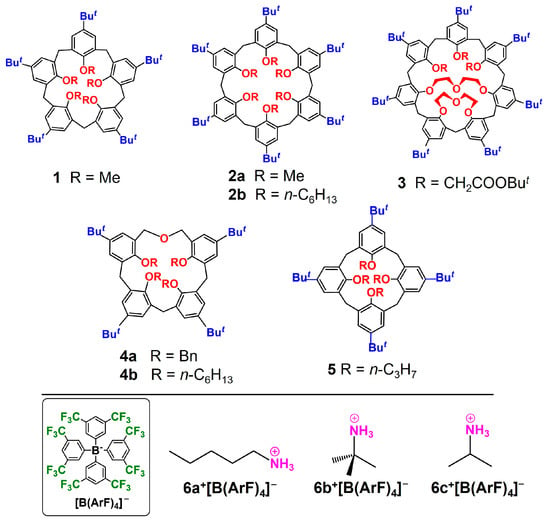
Chart 1.
Structures of calix[n]arene derivatives 1–5 and alkylammonium 6a−d+[B(ArF)4]− salts.
The calix[6]arene macrocycle can adopt eight distinct conformations (Figure 1), including cone, partial cone, 1,2-alternate, 1,3-alternate, 1,4-alternate, 1,2,3-alternate, 1,2,4-alternate, and 1,3,5-alternate [28,29,30], and conformational interconversion between them occurs by means of “oxygen-through-the-annulus” or/and “tert-butyl-through-the-annulus” passage.
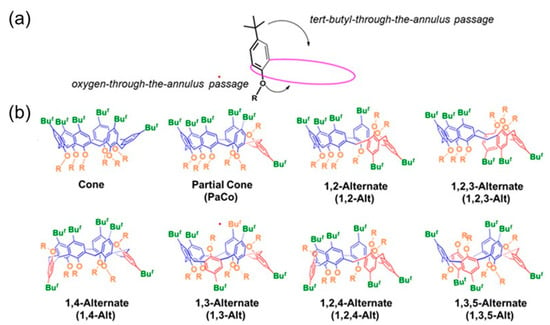
Figure 1.
(a) Possible pathways for conformational interconversion in p-tert-butylcalix[6]arenes. (b) The eight basic conformations of calix[6]arene derivatives.
As previously reported by us [30], the 1H NMR spectrum of hexahexyloxycalix[6]arene 2b in CDCl3 at 298 K (Figure 2a) shows broad signals indicative of a slow conformational mobility of the macrocycle with respect to the NMR time scale. We showed that after lowering the temperature to 233 K, the 1H NMR resonances of 2b decoalesced to form sharp signals compatible with the presence of 1,2,3-alternate (favored) and cone conformations of 2b. Based on these considerations, hexahexyloxycalix[6]arene 2b is the ideal candidate for studying the conformational response of the calix[6]arene skeleton to the presence of ammonium guests. The question to address now is specifically whether linear and branched alkylammonium cations 6a–c+ can form complexes with 2b, as well as the possibility of complexation-induced selection of the 1,2,3-alternate/cone or alternative conformations of hexahexyloxycalix[6]arene 2b.
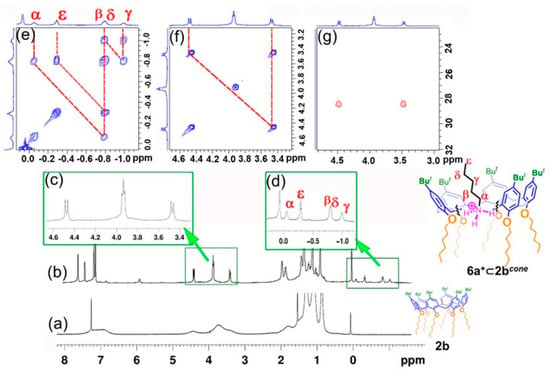
Figure 2.
1D and 2D NMR spectra (CDCl3, 600 MHz, 298 K) for the complexation of 6a+ by 2b. (a) 1H NMR spectrum of 2b; (b) 1H NMR spectrum of an equimolar solution of 2b and 6a+[B(ArF)4]− (3 mM); (c,d) enlargements of two different portions of (b); (e,f) portions of the COSY-45; and (g) HSQC spectrum (CDCl3, 600 MHz, 298 K) of the solution in (b).
Consequently, prompted by these considerations, we decided to investigate the molecular recognition properties of 2b toward linear and branched alkylammonium ions 6a–c+ as barfate salts [B(ArF)4]– (Chart 1).
2. Results and Discussion
2.1. Binding Ability of 2b toward n-Pentylammonium Guest 6a+[B(ArF)4]–
The complexation ability of 2b toward 6a+[B(ArF)4]– (Chart 1) was investigated at 298 K via 1D and 2D NMR experiments. The 1H NMR spectrum of an equimolar (3 mM) solution of 2b and 6a+[B(ArF)4]– in CDCl3 at 298 K showed typical features [24] of the presence of the endo-cavity 6a+⊂2b complex (Scheme 1). In particular, the formation of the complex was ascertained based on the appearance of a new set of slowly exchanging signals in the up-field negative region of the spectrum (Figure 2) attributable to the n-pentyl chain of 6a+ shielded inside the cavity of the calix[6]arene macrocycle.
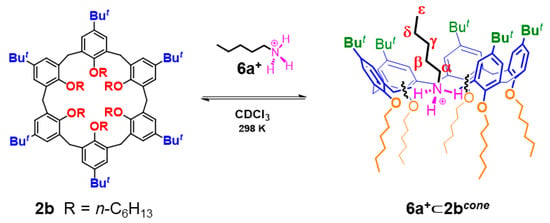
Scheme 1.
Formation of the 6a+⊂2bcone complex.
The NMR signals of 6a+ complexed inside the cavity of 2b were assigned via a COSY-45 experiment (Figure 2e). As a result, the NH3 + signal at 5.99 ppm correlated with the α-protons at –0.06 ppm, which coupled with the β-methylene group at –0.81 ppm. This, in turn, showed a cross peak with the γ-protons at –0.99 ppm. The γ-protons were coupled with the δ-methylene group at –0.81 ppm, which was correlated with the ε-methyl group at –0.28 ppm. The COSY-45 spectrum of the 6a+⊂2b complex revealed the presence of an AX system (Figure 2f) at 3.47/4.48 ppm (Δδ = 0.99 ppm), which correlated in the HSQC spectrum with a 13C resonance at 28.4 ppm, attributable to the ArCH2Ar groups. In agreement with Gutsche’s “1H NMR” rule [28,30] and the “13C NMR single rule” of de Mendoza [29,30], these results are only compatible with the formation of the endo-cavity 6a+⊂2bcone complex, in which the calix[6]arene adopts a cone conformation. In conclusion, the pentylammonium cation 6a+ selected the cone as the best-fitting 2b conformation at the expense of the 1,2,3-alternate, which was the most abundant species in the initial conformational equilibria of 2b [30].
The calculation of the binding constant for the formation of the 6a+⊂2bcone complex through direct peak integration was not possible, as the 1H NMR signals (Figure 2b) of the free 2b and guest 6a+ were not detected in the 1H NMR spectrum of their 1:1 mixture, shown in Figure 2b. Consequently, a binding constant calculation was performed by means of a competition experiment in which 1 equiv of pentylammonium 6a+ was mixed with a 1:1 mixture of 2b and n-butylammonium (in CDCl3) as barfate salt. Previously, we reported on the formation of the n-BuNH3+⊂2bcone complex in CDCl3 with a Kass value of 8.3 ± 0.1 × 106 M–1 [12,13,24,31]. After the mixing of 2b, n-BuNH3+, and 6a+ (1/1/1 molar ratio), the n-BuNH3+⊂2bcone complex was preferentially formed over the 6a+⊂2bcone one in a 1.6:1.0 ratio. Thus, from these data, a binding constant of 5.2 ± 0.1 × 106 M–1 was calculated for the formation of the 6a+⊂2bcone complex in CDCl3 at 298 K (see the Supplementary Materials for further details).
The DFT-optimized structure of the 6a+⊂2bcone complex (Figure 3), calculated on the B3LYP/6-31G(d,p) theoretical level, revealed that the N+ atom of 6a+ sits 0.30 Å above the mean plane of the ethereal oxygen atoms of 2b. H-bonding interactions were detected between the +NH3−ammonium group of 6a+ and the oxygen atoms of 2b, with a +N···O2b average distance of 2.83 Å and an average +N-H··· O2b angle of 165.1°. In addition, CH···π interactions were detected between the aromatic rings of 2b and the pentyl chain of 6a+ confined inside the cavity of 2b (Figure 2a–c), with an average C−H···πcentroid distance of 2.99 Å. A second-order perturbation theory SOPT analysis [32] of the Fock matrix in the NBO [33] basis and NCI (non-covalent interactions) studies were conducted in order to rationalize the energy contribution of secondary interactions.
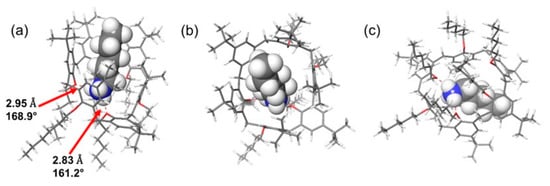
Figure 3.
(a–c) Different views of the DFT-optimized structure of the 6a+⊂2bcone complex. (a) Marked in red, +N–H···O, H-bonding mean distance and angle.
Interestingly, the SOPT analysis conducted on 6a+⊂2bcone indicated that a network of +N–H···O2b hydrogen bonding and C-H···π interactions stabilized the complex. We identified two lone-pair (LP) interactions between the oxygen atoms of 2b and the N–H antibonding orbitals (i.e., H-bonding interactions, Figure 3) of 6a+ in the 6a+⊂2b complex, which provided a 78% energetic contribution to the total stabilization energy of the complex.
2.2. Binding Ability of 2b toward Tert-Butylammonium Guest 6b+[B(ArF)4]–
With these results in hand, we focused our attention on a branched alkylammonium guest such as tert-butylammonium 6b+[B(ArF)4]–, which revealed a very different behaviour compared to 6a+[B(ArF)4]–. Close inspection of the 1H NMR spectrum (CDCl3, 600 MHz, 298 K) of the equimolar mixture 2b/6b+ (3 mM) in Figure 4 showed typical signals indicative of the endo-cavity complexation of 6b+ inside the cavity of 2b (Scheme 2).
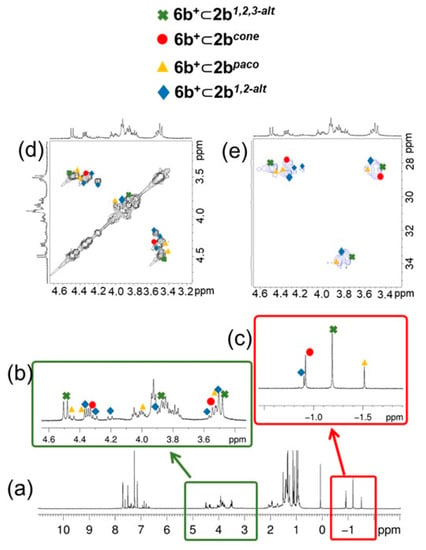
Figure 4.
The 1D and 2D NMR spectra (CDCl3, 600 MHz, 298 K) for the complexation of 6b+ by 2b. (a) 1H NMR spectrum of an equimolar solution of 2b and 6b+[B(ArF)4]–(3 mM). (b,c) Enlargements of two different portions of (a). (d,e) Portions of the COSY-45 and HSQC spectra (CDCl3, 600 MHz, 298 K) of the solution in (a).
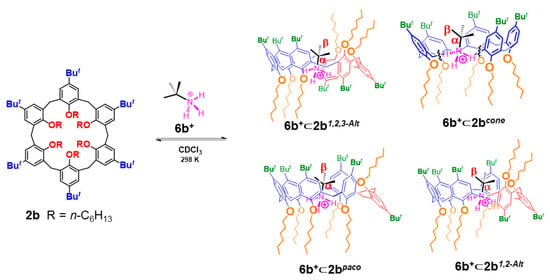
Scheme 2.
Endo-cavity complexation of tert-butylammonium 6b+ as barfate salt [B(ArF)4]– by 2b: formation of 6b+⊂2b1,2,3-Alt, 6b+⊂2bcone, 6b+⊂2bpaco, and 6b+⊂2b1,2-Alt complexes.
Closer inspection of the methylene region (4.5–3.4 ppm) in the COSY-45 spectrum of the equimolar mixture 2b/6b+ (3 mM) showed the presence of several AX systems (marked in red, blue, yellow, and green in Figure 4), which correspond to the formation of various 6b+⊂2b complexes in which the calix[6]arene macrocycle adopts different conformations. The 1D and 2D NMR analyses of the equimolar mixture 2b/6b+ (3 mM), supported with DFT calculations, made it possible to identify four complexes, namely, 6b+⊂2b1,2,3-alt, 6b+⊂2bcone, 6b+⊂2bpaco, and 6b+⊂2b1,2-alt (Scheme 2), in which the calix[6]arene host adopts the 1,2,3-alternate, cone, partial cone, and 1,2-alternate conformations, respectively.
The integration of the 1H NMR signals attributable to 6b+⊂2b1,2,3-alt, 6b+⊂2bcone, 6b+⊂2bpaco, and 6b+⊂2b1,2-alt revealed that the four complexes were present in a 6:3:2:1 ratio. From these data and through a quantitative 1H NMR experiment, using trichloroethylene (TCE) as the internal standard (see the experimental section for further details), the following apparent association constants were calculated: 2.6 ± 0.2 × 103 M–1 (6b+⊂2b1,2,3-alt); 1.8 ± 0.2 × 103 M–1 (6b+⊂2bcone), 8.1 ± 0.2 × 102 M–1 (6b+⊂2bpaco), and 4.3 ± 0.2 × 102 M–1 (6b+⊂2b1,2-alt).
These values clearly demonstrated that the binding of the branched tert-butylammonium cation is generally less favored than that of linear n-pentylammonium, probably due to the greater steric encumbrance of the t-Bu group.
For the sake of clarity, hereafter, we report on the analysis of the 1D and 2D NMR spectra in Figure 4, supporting the identification of the four complexes formed upon mixing 2b and 6b+ in an equimolar ratio (3 mM) in CDCl3 at 298 K.
6b+⊂2b1,2,3-alt: The presence of an ArCH2Ar AX system at 3.49/4.49 ppm and an AB system at 3.86/3.77 ppm provides evidence of the 6b+⊂2b1,2,3-alt complex, in which the calix[6]arene adopts a 1,2,3-alternate conformation. The HSQC correlations of these ArCH2Ar signals with carbon resonances at 28.3 and 33.7 ppm (Figure 4e) confirmed the presence of the calixarene host in the 1,2,3-alternate conformation, according to Gutsche’s “1H NMR” rule [28,30] and the “13C NMR single rule” of de Mendoza [29,30]. Finally, the tert-butyl singlet of 6b+ shielded inside the cavity of 2b1,2,3-alt was detected at −1.15 ppm (marked in green), a value significantly up-field-shifted as compared to the analogous signals of 6b+ hosted inside the cone-shaped cavity of 6b+⊂2bcone (−0.92 ppm, marked in red) and the 6b+⊂2b1,2-alt complex (−0.91 ppm, marked in blue) (vide infra).
6b+⊂2bcone: The methylene region of the 1H NMR spectrum in Figure 4a,b showed the presence of an AX system (COSY spectrum, indicated in red in Figure 4d) at 3.52/4.34 ppm (Δδ = 0.82 ppm), which correlated in the HSQC spectrum (Figure 4e) with a carbon resonance at 28.0 ppm, attributable to carbon atoms between syn-oriented aromatic rings. These signals can be assigned to the 6b+⊂2bcone complex, in which calix[6]arene 2b adopts the cone conformation. Interestingly, the tert-butyl signal of 6b+ shielded inside the aromatic cavity of 2bcone was found at −0.92 ppm (marked in red in Figure 4c).
6b+⊂2bpaco: The 1H NMR spectrum in Figure 4a,b showed the presence of two less intense AX systems (COSY spectrum, Figure 4d) in a 1:1 ratio at 3.48/4.45 ppm (Δδ = 0.97 ppm) and 3.51/4.35 ppm (Δδ = 0.84 ppm), which correlated in the HSQC spectrum (Figure 4e) with carbon resonances at 28.3 and 28.6 ppm, respectively, attributable to ArCH2Ar carbon atoms between syn-oriented aryl rings. In addition, an AB system (COSY spectrum) was detected at 3.86/3.99 ppm, attributable to ArCH2Ar groups between anti-oriented aryl rings, which correlated with a carbon resonance at 33.8 ppm. According to the application of Gutsche’s and de Mendoza’s rules, these data were indicative of the presence of a 6b+⊂2bpaco complex in which the calix[6]arene adopted the partial cone conformation. Additionally, in this case, a singlet was detected at −1.51 ppm (marked in yellow in Figure 4), attributable to the -C(CH3)3 group of 6b+ shielded inside the cavity of 2bpaco.
6b+⊂2b1,2-alt: The presence of the 6b+⊂2b1,2-alt complex was confirmed by three ArCH2Ar AX systems (COSY spectrum, Figure 4d) at 3.49/4.30, 3.51/4.20, and 3.51/4.36 ppm (Δδ = 0.81, 0.69, and 0.85 ppm, respectively) in a 1:1:2 ratio, which correlated in the HSQC spectrum with carbon signals at 28.5, 28.6, and 28.4 ppm, respectively, and an AB ArCH2Ar system at 3.86/3.96 ppm, which correlated with a carbon resonance at 33.6 ppm. In this case, in the negative region of the 1H NMR, we observed the tert-butyl singlet of 6b+ at –0.90 ppm (marked in blue in Figure 4c).
To investigate the energy contribution of noncovalent interactions, a SOPT analysis of the Fock matrix in the NBO basis was carried out on the DFT-optimized structures of the four 6b+⊂2b complexes.
The DFT-optimized structure of the 6b+⊂2b1,2,3-alt complex indicated the presence of stabilizing H-bonding and C−H∙∙∙π interactions between the guest 6b+ and 2b1,2,3-alt. A SOPT analysis indicated that the stabilization energy was mainly due to the formation of two +N–H···O2b H-bonding interactions, which contributed 80% of the total binding energy (Table 1). This value is significantly higher than that calculated for the +N−H···O2b H−bonding interactions of the 6b+⊂2bcone complex, which was 61% of the total energy of non-covalent interactions (Table 1) for this complex. The DFT-optimized structure of the 6b+⊂2bcone complex calculated on the B3LYP/6-31G(d,p) theoretical level (Figure 5a) showed the presence of two +N−H···O interactions with an average +N···O2b distance of 2.95 Å, being longer and weaker than that calculated for the 6b+⊂2b1,2,3-alt complex (+N···O2b average distance of 2.80 Å), while an average +N–H···O2b angle of 165.1° was calculated for the 6b+⊂2bcone complex (163.3° calculated for 6b+⊂2b1,2,3-alt). Additionally, C−H∙∙∙π interactions were detected between the tert-butyl group of 6b+ and the aromatic rings of 2b, with an average C-H···π centroid distance of 2.95 Å and an average C-H···π centroid angle of 153.3°.

Table 1.
Contribution of +N–H···O hydrogen-bonding interactions to the total binding energy, as calculated via SOPT analysis of the Fock matrix in the natural bond orbital (NBO) basis for the complexes between 6b+ and 2b in different conformations.
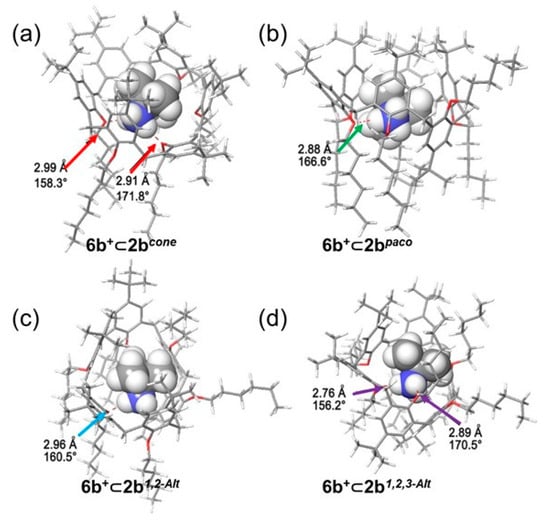
Figure 5.
DFT-optimized structures of the complexes 6b+⊂2b1,2,3-alt (a), 6b+⊂2bcone (b), 6b+⊂2bpaco (c), and 6b+⊂2b1,2-alt (d) calculated on the B3LYP/6-31G(d,p) theoretical level.
Concerning the DFT-optimized structure of 6b+⊂2bpaco (Figure 5b), a single H-bonding interaction was detected between the NH3+ group of 6b+ and an oxygen atom of 2bpaco, with a distance of 2.88 Å and an angle of 166.6°. The SOPT analysis revealed a lower value for the contribution of the +N–H···O2b hydrogen-bonding interaction (53%, Table 1).
Similarly, the DFT-optimized structure of the 6b+⊂2b1,2-alt complex (Figure 5c) suggested the existence of a single H-bonding interaction between the ammonium group of 6b+ and an oxygen atom of 2b1,2-alt. Here, the SOPT analysis also revealed a lower 36% contribution of the +N–H···O2b hydrogen-bonding interaction (Table 1) to the total binding energy.
These results clearly indicate that the tert-butylammonium guest 6b+ prefers the 1,2,3-alt–2b as the best-fitting host conformation to a greater extent than the other conformations. In addition, the NCI analysis suggests that the stabilization induced by the H-bonding interactions between the ammonium group of 6b+ and the oxygen atoms of the calixarene 2b (+N–H···O) plays a crucial role in determining the thermodynamic stabilities of the four complexes shown in Scheme 2. A careful comparison of the DFT-optimized structures of the 6a+⊂2b and 6b+⊂2b complexes reveals significant differences in the binding modes of the two guests. In particular, the greater steric requirements of the tert-butyl group of 6b+ force it to occupy a deeper position inside the calix[6]arene cavity (in each of the four conformations), leading to greater deformation of the host, which, in turn, implies a higher energetical cost and a lower binding constant. In this way, the deeply positioned 6b+ guest is able to form two stabilizing H-bonds with the 1,2,3-alt- and cone-2b conformations, whereas only one H-bond is possible with the other paco- and 1,2-alt-2b isomers.
2.3. Binding Ability of 2b toward Isopropylammonium Guest 6c+[B(ArF)4]–
The endo-cavity complexation of the isopropylammonium guest 6c+[B(ArF)4]– showed very similar features to those observed in the complexation of the tert-butylammonium guest 6b+ with 2b. In fact, the 1D and 2D NMR analysis of an equimolar mixture of 6c+[B(ArF)4]– and 2b resulted in the formation of a well-defined mixture of stereoisomeric complexes in which the calix[6]arene adopted different conformations, namely, 6c+⊂2b1,2,3-alt, 6c+⊂2bcone, 6c+⊂2bpaco, and 6c+⊂2b1,2-alt (Figure 6). The four complexes were found in a 9:3:2:1 ratio according to the integration of their 1H NMR signals.
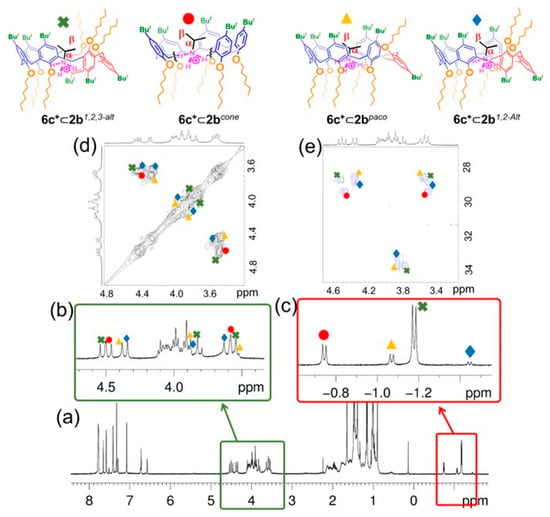
Figure 6.
The 1D and 2D NMR spectra (CDCl3, 600 MHz, 298 K): (a) 1H NMR spectrum of an equimolar solution of 2b and 6b+[B(ArF)4]– (3 mM); (b,c) enlargements of two different portions of (a); (d,e) portions of the COSY-45 and HSQC spectra (CDCl3, 600 MHz, 298 K) of the solution in (a).
Through a quantitative 1H NMR (CDCl3, 600 MHz, 298 K) experiment, using TCE as the internal standard, four binding constants were calculated for the slowly exchanging complexes: 3.1 ± 0.2 × 104 M−1 for 6c+⊂2b1,2,3-alt, 9.1 ± 0.2 × 103 M−1 for 6c+⊂2bcone, 6.1 ± 0.2 × 103 M−1 for 6c+⊂2bpaco, and 1.2 ± 0.2 × 103 M−1 for 6c+⊂2b1,2-alt (SI).
These results clearly confirmed the role of the steric encumbrance, since the binding of the more branched tert-butylammonium cation is less favored than that of the less branched i-propylammonium, which, in turn, is less favored with respect to linear n-pentylammonium.
The 1H NMR spectrum (600 MHz, 298 K, Figure 6a–c) of a 1:1 mixture of 6c+[B(ArF)4]–and 2b (3 mM) in CDCl3 showed a series of doublets shielded at the negative values of chemical shifts and attributable to endo-cavity complexed β–CH3 groups of 6c+: −1.50 (J = 6.8 Hz), −1.23 (J = 6.8 Hz), −1.13 (J = 6.8 Hz), −0.68 (J = 6.8 Hz) ppm, assigned to 6c+⊂2b1,2-alt, 6c+⊂2b1,2,3-alt, 6c+⊂2bpaco, and 6c+⊂2bcone, respectively.
6c+⊂2b1,2,3-alt: The formation of the 6c+⊂2b1,2,3-alt complex, in which the calix[6]arene adopts a 1,2,3-alternate conformation, was ascertained according to the presence of an AX system at 3.47/4.46 ppm (Δδ = 1.00 ppm; HSQC: 1J correlation with an Ar13CH2Ar signal at 28.3 ppm) and an AB system at 3.73/3.81 ppm (Δδ = 0.08 ppm; HSQC: 1J correlation with an ArCH2Ar signal at 34.0 ppm, marked in green in Figure 6).
6b+⊂2bcone: The formation of the 6b+⊂2bcone complex was established based on the presence of an AX system at 3.48/4.41 ppm, which correlated in the HSQC spectrum (Figure 6e) with a carbon resonance at 28.0 ppm, attributable to carbon atoms between syn-oriented aromatic rings (red marked in Figure 6).
6c+⊂2bpaco: The 1H NMR and COSY-45 spectra of the 6c+⊂2bpaco complex showed two AX systems at 3.54/4.29 ppm (Δδ = 0.75) and 3.53/4.29 ppm (Δδ = 0.76) in 1:1 ratio, which correlated in the HSQC spectrum (Figure 6e) with carbon resonances at 28.3 and 28.6 ppm, respectively. Moreover, the HSQC spectrum of the complex showed a correlation between a carbon resonance at 34.0 ppm and an AB system at 3.81/4.01) ppm, attributable to ArCH2Ar groups between anti-oriented Ar rings.
6c+⊂2bpaco: The presence of three ArCH2Ar AX systems (COSY spectrum, Figure 6d) at 3.47/4.40, 3.52/4.34, and 3.57/4.20 ppm (Δδ = 0.93, 0.82, and 0.63 ppm, respectively) in a 1:1:2 ratio (indicated in blue in Figure 6) is compatible with the presence of the 6c+⊂2b1,2-alt complex.
The H-bonding contribution to the total binding energy calculated for the four 6c+⊂2b complexes (Table 2) is in agreement with their thermodynamic stability order evaluated based on Kass values in CDCl3 at 298 K: 6c+⊂2b1,2,3-alt > 6c+⊂2bcone > 6c+⊂2bpaco > 6c+⊂2b1,2-alt. These results clearly indicate that, once again, the 1,2,3-alt-2b was selected as the best-fitting host conformation in the presence of a branched alkylammonium guest such as 6c+. The stability order of the 6c+⊂2b complexes is in full agreement with that observed in the presence of the tert-butylammonium guest 6b+. The natural bond orbital and noncovalent interaction analyses indicate that H-bonding interactions between the ammonium group of 6c+ and the oxygen atoms of the calixarene 2b (+N–H···O) provide the key stabilization factor for the 6c+⊂2b complexes. In fact, they account for 87%, 77%, 66%, and 52% of the total binding energy for the 6c+⊂2b1,2,3-alt, 6c+⊂2bcone, 6c+⊂2bpaco, and 6c+⊂2b1,2-alt complexes, respectively (Table 2).

Table 2.
Contribution of +N–H···O hydrogen-bonding interactions to the total binding energy, as calculated via SOPT analysis of the Fock matrix in the natural bond orbital (NBO) basis for the complexes between 6c+ and 2b in different conformations.
At this point, it was important to verify whether the thermodynamic stability of the individual conformational complexes was in accordance with the Expanding Coefficient (EC) parameter recently proposed by our group [34]. In fact, it was found that the EC parameter can be conveniently correlated with the thermodynamic stability of supramolecular complexes obeying the induced-fit or conformational selection models and governed by weak secondary interactions. EC is defined as the ratio between the volume of the host cavity after complexation and that of the host cavity before complexation [34].
The EC values were thus calculated from the cavity volumes of the complexed and free host using the above DFT-optimized structures and that of the 1,2,3-alternate ground 2b host for all the 6b+⊂2b and 6c+⊂2b complexes (SI) with the Caver software [35,36,37]. In detail, taking the 6c+⊂2b complexes as an example, the EC values of 6.03, 6.37, 4.84, and 6.03 were found for 6c+⊂2b1,2,3-alt, 6c+⊂2bcone, 6c+⊂2bpaco, and 6c+⊂2b1,2-alt, respectively, whose log Kapp values were 4.49, 3.96, 3.79, and 3.08, respectively (SI). As is clearly evident, the previously observed linear correlation between the EC and log Kapp [34] is not a factor here [30]. This can be easily explained by considering the number of H-bonding interactions, which, as stated above, is the main determinant of the thermodynamic stability of these complexes. Thus, if we only consider those complexes with two H-bonding interactions, 6c+⊂2b1,2,3-alt (EC = 6.03, log Kapp = 4.49) and 6c+⊂2bcone, (EC = 6.37, log Kapp = 3.96), we find a good correlation between an increasing EC and decreasing log Kapp. In the same way, considering only those complexes with one H-bonding interaction, 6c+⊂2bpaco (EC = 4.84, log Kapp = 3.79) and 6c+⊂2b1,2-alt (EC = 6.03, log Kapp = 3.08), we again find a good correlation between an increasing EC and decreasing log Kapp. Therefore, these findings are in accordance with our previous statement [34] that “the EC parameter can be considered of general applicability in all those instances in which no new strong intermolecular interactions (e.g., H-bonds) are generated during the induced-fit process”.
3. Conclusions
This study clearly shows that hexahexyloxycalix[6]arene 2b can complex alkylammonium guests and shows a conformational adaptive behavior. Thus, in the presence of n-pentylammonium 6a+, the cone-2b is the best-fitting conformation at the expense of the 1,2,3-alternate-2b, which is the most abundant conformer in the absence of a guest. In a different way, branched alkylammonium guests, such as tert-butylammonium 6b+ and isopropylammonium 6c+, select a combination of conformers of 2b. Four complexes were revealed and characterized using 1D and 2D NMR spectra, in which 2b adopted different conformations, namely, 6b+/6c+⊂2b1,2,3-alt, 6b+/6c+⊂2bcone, 6b+/6c+⊂2bpaco, and 6b+/6c+⊂2b1,2-alt. The binding constant values determined through NMR experiments indicated that the 1,2,3-alternate was the best-fitting 2b conformation for the complexation of branched alkylammonium guests, followed by cone > paco > 1,2-alt. The NCI and NBO calculations suggest that the H-bonding interactions between the ammonium group of the guest and the oxygen atoms of the calixarene 2b (+N–H···O) played a crucial role in determining the thermodynamic stability order of the four complexes. In addition, it was found that an increase in branching from n-Pent to i-Pr and in t-Bu groups leads to a corresponding decrease in binding affinity. Therefore, it can be concluded that higher steric encumbrance leads to weaker H-bonding interactions and, hence, to a lower binding energy.
Supplementary Materials
The following supporting information can be downloaded at: https://www.mdpi.com/article/10.3390/molecules28124749/s1, Supplementary Materials containing the procedure for the formation of alkylammonium@calixarene complexes; 1D and 2D NMR spectra of complexes (Figures S1–S21); details of DFT, NBO/NCI, calculations and stability constant determination [38].
Author Contributions
Conceptualization, C.G., C.T. and P.N.; methodology and investigation, V.I.; data curation, P.D.S.; writing—original draft preparation, V.I. and P.D.S.; writing—review and editing, P.N., C.T. and C.G.; visualization, A.S. and M.D.R.; supervision, P.N. and C.G.; project administration, P.N. All authors have read and agreed to the published version of the manuscript.
Funding
This research was funded by the UNIVERSITY of SALERNO, FARB 2021.
Data Availability Statement
Not applicable.
Conflicts of Interest
The authors declare no conflict of interest.
References
- Atwood, J.L.; Davies, J.E.D.; Macnicol, D.D.; Vogtle, F. Comprehensive Supramolecular Chemistry; Pergamon Press: New York, NY, USA, 1996. [Google Scholar]
- Hammes, G.G.; Chang, Y.-C.; Oas, T.G. Conformational selection or induced fit: A flux description of reaction mechanism. Proc. Natl. Acad. Sci. USA 2009, 106, 13737–13741. [Google Scholar] [CrossRef] [PubMed]
- Monod, J.; Wyman, J.; Changeux, J.-P. On the nature of allosteric transitions: A plausible model. J. Mol. Biol. 1965, 12, 88–188. [Google Scholar] [CrossRef] [PubMed]
- Paul, F.; Weikl, T.R. How to Distinguish Conformational Selection and Induced Fit Based on Chemical Relaxation Rates. PLoS Comput. Biol. 2016, 12, e1005067. [Google Scholar] [CrossRef] [PubMed]
- Koshland, D.E. Application of a Theory of Enzyme Specificity to Protein Synthesis. Proc. Natl. Acad. Sci. USA 1958, 44, 98–104. [Google Scholar] [CrossRef]
- Takahashi, D.T.; Gadelle, D.; Agama, K.; Kiselev, E.; Zhang, H.; Yab, E.; Petrella, S.; Forterre, P.; Pommier, Y.; Mayer, C. Topois merase I (TOP1) Dynamics: Conformational Transition from Open to Closed States. Nat. Commun. 2022, 13, 59. [Google Scholar] [CrossRef]
- Miles, T.F.; Bower, K.S.; Lester, H.A.; Dougherty, D.A. A Coupled Array of Noncovalent Interactions Impacts the Function of the 5-HT 3 A Serotonin Receptor in an Agonist-Specific Way. ACS Chem. Neurosci. 2012, 3, 753–760. [Google Scholar] [CrossRef]
- Duffy, N.H.; Lester, H.A.; Dougherty, D.A. Ondansetron and Granisetron Binding Orientation in the 5-HT3 Receptor Determined by Unnatural Amino Acid Mutagenesis. ACS Chem. Biol. 2012, 7, 1738–1745. [Google Scholar] [CrossRef]
- Gaeta, C.; Talotta, C.; Farina, F.; Campi, G.; Camalli, M.; Neri, P. Conformational Features and Recognition Properties of a Confo mationally Blocked Calix[7]Arene Derivative. Chem. Eur. J. 2012, 18, 1219–1230. [Google Scholar] [CrossRef] [PubMed]
- Fan, J.; Chen, Y.; Cao, D.; Yang, Y.-W.; Jia, X.; Li, C. Host–Guest Properties of Pillar[7]Arene towards Substituted Adamantane Ammonium Cations. RSC Adv. 2014, 4, 4330–4333. [Google Scholar] [CrossRef]
- Li, C.; Shu, X.; Li, J.; Fan, J.; Chen, Z.; Weng, L.; Jia, X. Selective and Effective Binding of Pillar[5,6]Arenes toward Secondary Ammonium Salts with a Weakly Coordinating Counteranion. Org. Lett. 2012, 14, 4126–4129. [Google Scholar] [CrossRef]
- Della Sala, P.; Del Regno, R.; Talotta, C.; Capobianco, A.; Hickey, N.; Geremia, S.; De Rosa, M.; Spinella, A.; Soriente, A.; Neri, P.; et al. Prismarenes: A New Class of Macrocyclic Hosts Obtained by Templation in a Thermodynamically Controlled Synthesis. J. Am. Chem. Soc. 2020, 142, 1752–1756. [Google Scholar] [CrossRef]
- Della Sala, P.; Del Regno, R.; Di Marino, L.; Calabrese, C.; Palo, C.; Talotta, C.; Geremia, S.; Hickey, N.; Capobianco, A.; Neri, P.; et al. An Intramolecularly Self-Templated Synthesis of Macrocycles: Self-Filling Effects on the Formation of Prismarenes. Chem. Sci. 2021, 12, 9952–9961. [Google Scholar] [CrossRef] [PubMed]
- Della Sala, P.; Del Regno, R.; Iuliano, V.; Capobianco, A.; Talotta, C.; Geremia, S.; Hickey, N.; Neri, P.; Gaeta, C. Confused Prism[5]arene: A Conformationally Adaptive Host by Stereoselective Opening of the 1,4-Bridged Naphthalene Flap. Chem. Eur. J. 2023, 29, e202203030. [Google Scholar] [CrossRef]
- Mock, W.L.; Shih, N.Y. Structure and Selectivity in Host-Guest Complexes of Cucurbituril. J. Org. Chem. 1986, 51, 4440–4446. [Google Scholar] [CrossRef]
- Yang, L.-P.; Wang, X.; Yao, H.; Jiang, W. Naphthotubes: Macrocyclic Hosts with a Biomimetic Cavity Feature. Acc. Chem. Res. 2020, 53, 198–208. [Google Scholar] [CrossRef] [PubMed]
- Jia, F.; He, Z.; Yang, L.-P.; Pan, Z.-S.; Yi, M.; Jiang, R.-W.; Jiang, W. Oxatub[4]Arene: A Smart Macrocyclic Receptor with Multiple Interconvertible Cavities. Chem. Sci. 2015, 6, 6731–6738. [Google Scholar] [CrossRef]
- Della Sala, P.; Talotta, C.; Caruso, T.; De Rosa, M.; Soriente, A.; Neri, P.; Gaeta, C. Tuning Cycloparaphenylene Host Properties by Chemical Modification. J. Org. Chem. 2017, 82, 9885–9889. [Google Scholar] [CrossRef]
- Li, J.; Zhou, H.; Han, Y.; Chen, C. Saucer[n]arenes: Synthesis, Structure, Complexation, and Guest-Induced Circularly Polarized Luminescence Property. Angew. Chem. Int. Ed. 2021, 60, 21927–21933. [Google Scholar] [CrossRef]
- Jia, F.; Li, D.; He, S.; Yang, L.; Jiang, W. Conformational Effects on the Threading Kinetics of Dumbbell-Shaped Guests into the Cavity of Oxatub[4]Arene. Angew. Chem. Int. Ed. 2022, 61, e2022123. [Google Scholar] [CrossRef]
- Wang, X.; Jia, F.; Yang, L.-P.; Zhou, H.; Jiang, W. Conformationally Adaptive Macrocycles with Flipping Aromatic Sidewalls. Chem. Soc. Rev. 2020, 49, 4176–4188. [Google Scholar] [CrossRef]
- Del Regno, R.; Della Sala, P.; Spinella, A.; Talotta, C.; Iannone, D.; Geremia, S.; Hickey, N.; Neri, P.; Gaeta, C. Calix[2]Naphth[2]Arene: A Class of Naphthalene–Phenol Hybrid Macrocyclic Hosts. Org. Lett. 2020, 22, 6166–6170. [Google Scholar] [CrossRef] [PubMed]
- De Rosa, M.; Talotta, C.; Gaeta, C.; Soriente, A.; Neri, P.; Pappalardo, S.; Gattuso, G.; Notti, A.; Parisi, M.F.; Pisagatti, I. Calix[5]arene through-the-Annulus Threading of Dialkylammonium Guests Weakly Paired to the TFPB Anion. J. Org. Chem. 2017, 82, 5162–5168. [Google Scholar] [CrossRef] [PubMed]
- Gaeta, C.; Troisi, F.; Neri, P. Endo-Cavity Complexation and Through-the-Annulus Threading of Large Calixarenes Induced by Very Loose Alkylammonium Ion Pairs. Org. Lett. 2010, 12, 2092–2095. [Google Scholar] [CrossRef]
- Gaeta, C.; Talotta, C.; Farina, F.; Teixeira, F.A.; Marcos, P.M.; Ascenso, J.R.; Neri, P. Alkylammonium Cation Complexation into the Narrow Cavity of Dihomooxacalix[4]Arene Macrocycle. J. Org. Chem. 2012, 77, 10285–10293. [Google Scholar] [CrossRef]
- Talotta, C.; Gaeta, C.; De Rosa, M.; Ascenso, J.R.; Marcos, P.M.; Neri, P. Alkylammonium Guest Induced-Fit Recognition by a Flexible Dihomo oxacalix[4]Arene Derivative: Alkylammonium Guest Induced-Fit Recognition. Eur. J. Org. Chem. 2016, 2016, 158–167. [Google Scholar] [CrossRef]
- Talotta, C.; Gaeta, C.; Neri, P. Endo-Complexation of Alkylammonium Ions by Calix[4]Arene Cavity: Facilitating Cation−π Inte actions through the Weakly Coordinating Anion Approach. J. Org. Chem. 2014, 79, 9842–9846. [Google Scholar] [CrossRef]
- Kanamathareddy, S.; Gutsche, C.D. Calixarenes. 29. Aroylation and Arylmethylation of Calix[6]Arenes. J. Org. Chem. 1992, 57, 3160–3166. [Google Scholar] [CrossRef]
- Jaime, C.; De Mendoza, J.; Prados, P.; Nieto, P.M.; Sanchez, C. Carbon-13 NMR Chemical Shifts. A Single Rule to Determine the Conformation of Calix[4]Arenes. J. Org. Chem. 1991, 56, 3372–3376. [Google Scholar] [CrossRef]
- Gaeta, C.; Talotta, C.; Neri, P. Calix[6]Arene-Based Atropoisomeric Pseudo[2]Rotaxanes. Beilstein J. Org. Chem. 2018, 14, 2112–2124. [Google Scholar] [CrossRef]
- Hirose, K. Analytical Methods in Supramolecular Chemistry; Schalley, C.A., Ed.; Wiley-VCH: Weinheim, Germany, 2007; Chapter 2; pp. 17–54. [Google Scholar]
- Weinhold, F.; Landis, C.R. Valency and Bonding: A Natural Bond Orbital Donor-Acceptor Perspective, 1st ed.; Cambridge University Press: Cambridge, UK, 2005. [Google Scholar]
- Johnson, E.R.; Keinan, S.; Mori-Sánchez, P.; Contreras-García, J.; Cohen, A.J.; Yang, W. Revealing Noncovalent Interactions. J. Am. Chem. Soc. 2010, 132, 6498–6506. [Google Scholar] [CrossRef]
- Talotta, C.; Concilio, G.; de Rosa, M.; Soriente, A.; Gaeta, C.; Rescifina, A.; Ballester, P.; Neri, P. Expanding coefficient: A parameter to assess the stability of induced-fit complexes. Org. Lett. 2021, 23, 1804–1808. [Google Scholar] [CrossRef] [PubMed]
- Jurcik, A.; Bednar, D.; Byska, J.; Marques, S.M.; Furmanova, K.; Daniel, L.; Kokkonen, P.; Brezovsky, J.; Strnad, O.; Stourac, J.; et al. CAVER analyst 2.0: Analysis and visualization of channels and tunnels in protein structures and molecular dynamics trajectories. Bioinformatics 2018, 34, 3586–3588. [Google Scholar] [CrossRef] [PubMed]
- Frisch, M.J.; Trucks, G.W.; Schlegel, H.B.; Scuseria, G.E.; Robb, M.A.; Cheeseman, J.R.; Scalmani, G.; Barone, V.; Mennucci, B.; Petersson, G.A.; et al. Gaussian 16, Revision A.03; Gaussian Inc.: Wallingford, CT, USA, 2016. [Google Scholar]
- Krieger, E.; Vriend, G. YASARA View-molecular graphics for all devices-from smartphones to workstations. Bioinformatics 2014, 30, 2981–2982. [Google Scholar] [CrossRef] [PubMed]
- Lu, T.; Chen, F.W. Multiwfn: A multifunctional wavefunction analyzer. J. Comput. Chem. 2012, 33, 580. [Google Scholar] [CrossRef]
Disclaimer/Publisher’s Note: The statements, opinions and data contained in all publications are solely those of the individual author(s) and contributor(s) and not of MDPI and/or the editor(s). MDPI and/or the editor(s) disclaim responsibility for any injury to people or property resulting from any ideas, methods, instructions or products referred to in the content. |
© 2023 by the authors. Licensee MDPI, Basel, Switzerland. This article is an open access article distributed under the terms and conditions of the Creative Commons Attribution (CC BY) license (https://creativecommons.org/licenses/by/4.0/).